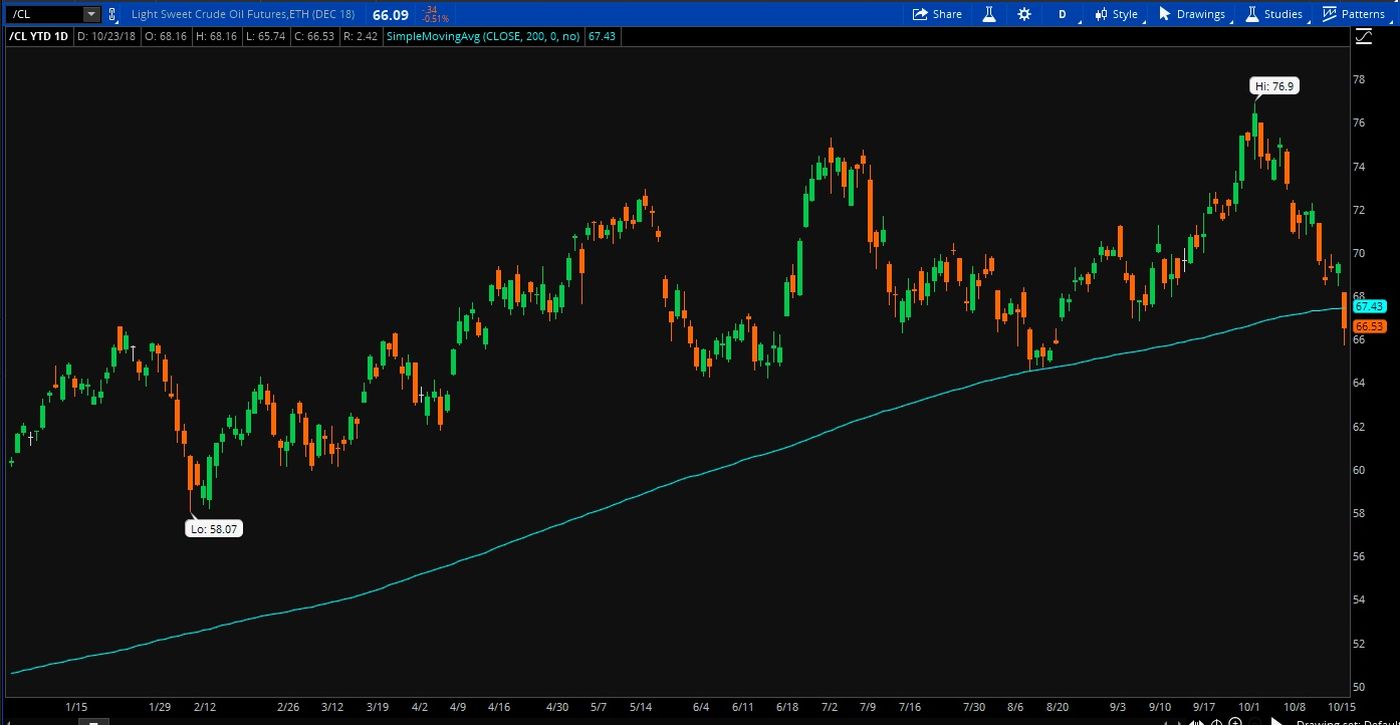(Wednesday Market Open) A mixed earnings picture early Wednesday seems to have U.S. stocks searching for direction after yesterday’s dramatic midday reversal. Most overseas markets moved higher, but it’s unclear if Wall Street can build on the positive energy that carried indices back from huge early losses Tuesday.
Futures prices did come back pretty well from losses last night, but still pointed down for the Nasdaq (COMP) and S&P 500 (SPX) in the early going. The Dow Jones Industrial Average (DJI) seemed ready to jump out to gains.
Big Earnings Week Rolls On
Boeing (NYSE:BA) looked like the earnings standout Wednesday, posting earnings per share of $3.58 and revenue of $25.15 billion as the company’s defense and services businesses shined. Results easily topped third-party consensus estimates of $3.47 and $23.94 billion, and BA also raised its guidance. Shares jumped more than 4% in pre-market trading, which could help boost the DJIA today. In fact, the DJIA rose more than 100 points in pre-market trading, likely in part due to strength in BA.
That contrasted with slight pre-market drops in the S&P 500 and Nasdaq, which contributed to the perception of a slightly rudderless situation, at least early on. It wouldn’t be all that surprising to see things wander around a bit after a day like yesterday, which might have left some investors feeling like their heads are spinning from the whipsaw action.
Earnings news from AT&T (NYSE:T) and United Parcel Service (NYSE:UPS), the other big hitters early Wednesday aside from BA, wasn’t as impressive. UPS met analysts’ earnings estimate but fell short on the revenue line, and shares fell nearly 3%. T beat estimates on revenue but missed on earnings and saw its shares take a 3% hit. T’s miss wasn’t that big, but the stock got punished.
Last night, Texas Instruments (NASDAQ:TXN) had a revenue miss, and the stock plunged 6% in pre-market trading. This one could be worth keeping an eye on considering the info tech sector remains in the spotlight. In financials, Capital One Financial (NYSE:COF) beat Wall Street’s expectations but saw revenue fall year over year.
The weaker-than-expected revenue at UPS is probably going to be talked about today, because sometimes results from the big shipping companies can be seen as barometers for the economy. However, the miss was only a few million dollars out of more than a $17.4 billion quarter, and U.S. revenue growth topped 8%, so investors might want to keep that in perspective. Generally, things looked strong on the revenue side, and UPS was able to get better pricing, which seems like a positive development.
Aside from earnings, investors might want to look out for September new home sales data this morning. Housing continues to be a struggling sector despite the booming economy. In addition, home price growth slowed to a more than six-year low in the UK, according to media reports. That could be another sign of economic struggles in the country as it wrestles with Brexit negotiations, and weakness overseas sometimes has a way of spreading to the U.S.
More Results On Tap After The Bell
With the morning’s earnings batch out of the way, investors might focus on a new crop due this afternoon. Not the least of which is Microsoft (NASDAQ:MSFT). For the quarter, MSFT is expected to report adjusted EPS of $0.96, up from $0.84 in the prior-year quarter, on revenue of $27.9 billion, according to third-party consensus analyst estimates. Revenue is projected to increase 13.7% year over year. MSFT has a long streak of beating analysts’ expectations, with revenue beating estimates in 19 of the last 20 quarters.
While several of MSFT’s divisions have reportedly been growing at a double-digit pace, the company’s cloud services divisions have been the major driver of revenue growth. When it last reported, revenue in the intelligent cloud division grew 23% year over year to $9.6 billion. Azure, the company’s cloud computing platform, grew 89% year over year, the fastest out of all of its products and services.
Ford (NYSE:F) is another bellwether due to report after the close, For Q3, F is expected to report adjusted EPS of $0.28, down from $0.43 in the prior-year quarter, on revenue of $33.3 billion, according to third-party consensus analyst estimates. Revenue is projected to decline 1% year over year.
The company has been in the midst of a turnaround strategy, which has included eliminating pretty much its entire lineup of sedans to focus on pickups, SUVs and crossover-style vehicles. In July, CEO Jim Hackett announced that F would embark on an $11 billion restructuring, but so far some analysts have expressed frustration that there hasn’t been much detail. After F canceled an investor meeting originally planned for September, that pretty much leaves today’s earnings as the only opportunity for analysts to dig into the company’s operations.
Other major companies reporting this afternoon include Advanced Micro Devices (NASDAQ:AMD), Tesla (NASDAQ:TSLA) and Visa (NYSE:V). Tomorrow morning brings Twitter (NYSE:TWTR), American Airlines (NASDAQ:AAL) and Union Pacific (NYSE:UNP), while tomorrow afternoon features Amazon.com (NASDAQ:AMZN) and Snap (NYSE:SNAP).
Watching Those Potential Support Levels
Yesterday’s early plunge and late surge might be a hard one for the market to top, at least for those who find entertainment value in those kind of sharp moves. The level to consider watching today, and possibly for the near future, is at around 2710 in the S&P 500. That’s the early October low that got briefly taken out intraday yesterday but which the market ended up closing above. A close below that might suggest more weakness, but there did seem to be considerable buying interest down there yesterday, so we’ll see if that continues to hold.
Despite the dramatic back and forth yesterday, volatility didn’t come close to testing recent highs of around 28 for the VIX. That could be a sign that at least some investors don’t expect too much additional downside pressure on the markets, at least not in the near term. The CBOE VIX—the most widely followed “fear index”—climbed 5% by the end of the day Tuesday, but at around 20 didn’t seem to be really spreading much fear a week out from Halloween. VIX remained just above 20 early Wednesday.
Volatility remains elevated from late summer when the VIX fell under 12. Anyone who thinks volatility won’t be a factor moving forward could be fooling themselves. Though past isn’t necessary prologue, history shows that these more volatile periods can take a while for the market to work out of, especially at times like these with an election ahead. For long-term investors, high volatility markets can send out a signal to consider taking extra caution going in and out of positions. This isn’t necessarily a time when anyone should be thinking about going “all in” or “all out.” Instead, consider bite-sized moves if the extra trading fees aren’t a burden.
From a sector perspective, some of the most beaten down stocks found some buyers late yesterday. These include homebuilders, a few of the banks, and even International Business Machines (NYSE:IBM). However, it was Apple (NASDAQ:AAPL) that really appeared to help lead the comeback, with what seemed to be conviction behind the buying.
Sector Struggles
Looking from a 50,000 foot view, materials are the worst performing sector over the last month, down about 13%. Financials have fallen around 9%, and industrials around 8%. Utilities are the only positive sector over that stretch, followed by staples. But neither Treasury notes nor gold—two traditional areas investors have often bought during down periods—have really had much buying interest despite the stock market’s struggles.
Speaking of struggles, crude oil could be the poster child this week (see Fig. 1 below). U.S. crude futures dipped below $66 a barrel at one point Tuesday, down around $10 from recent highs. Saudi Arabia’s jawboning appeared to weigh on oil as the country promised it would keep the market supplied even when new U.S. sanctions against Iran take effect early next month. Earlier fears that the controversy surrounding the death of a Saudi journalist might push oil prices higher seem to be replaced by concerns that lower demand from slumping economies in China and Europe might keep prices weighed down.
Energy sector shares are off nearly 6% over the last month, and transport shares have taken a big plunge. However, lower energy costs, if they stick around, could potentially give airline and railway companies a boost.
Figure 1: Crude Retreat: This year-to-date chart shows that the most actively traded December crude oil futures contract dipped yesterday below its 200-day moving average (blue line) for the first time all year. Often, though not always, a drop below a long-term moving average can be a sign of more weakness to come. Data Source: CME Group (NASDAQ:CME). Chart source: The thinkorswim® platform from TD Ameritrade. For illustrative purposes only. Past performance does not guarantee future results.
I’m (Not) Moving Out: There was some disconcerting real estate market news recently from one big state that might speak to troubled times in the housing industry. Home sales in Illinois fell more than 10% in September from a year earlier. The numbers were even worse just looking at the nine-county Chicago metro area, where the great majority of Illinois residents live. Sales there fell 12%. Even as sales fell by more than 1,000 homes statewide, prices rose more than 3%.“Consumers this fall are confronted with fewer options when they are looking for a new home,” said Ed Neaves, Illinois REALTORS® president-elect, in a press release. “Low inventories, coupled with increases in interest rates, are making it much tougher for some buyers to make a move, even though the data suggests many very much do want to make a purchase.” This observation is only for Illinois, but judging from a preponderance of recent national data, it might hold true for many other states as well, a possible weight on homebuilder, home renovation, and home appliance stocks.
Rate Hikes Still Seen Despite Weak Stocks: Atlanta Fed President Raphael Bostic yesterday seemed to reconfirm the Fed’s relatively hawkish recent stance, following Fed Chair Jerome Powell’s recent remarks that rates are a long way from neutral. Perhaps with that in mind, investors appear to be dialing in firm chances of a fourth rate hike this year. Odds of a December hike are above 80%, according to CME Fed funds futures, and odds are roughly 50% for an additional rate increase next March. However, there doesn’t seem to be as much of a chance for a third rate hike by the middle of 2019, with futures showing less than a one-third chance. It’s tough to predict that far out, but perhaps some of the geopolitical concerns and recent shakier corporate outlooks could be playing into that number for now.

